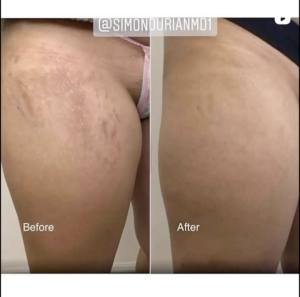In the world of self-care and personal improvement, achieving skin is an aspiration, for many stretch marks represent moments in the story of life, symbols of growth, transformation, and resilience. What if we could redefine these symbols to reflect rejuvenated skin? As we explore this topic, our aim is to empower you with knowledge and techniques that will enable you to embrace a chapter in your life.
Discover the opportunity that chemical peels and topical cream brings to rejuvenate and refresh your skin with stretch mark removal.
How do chemical peels and topical creams work in relation to treating stretch marks?
Chemical peels involve applying chemical solutions that help remove the layer of the skin, encouraging collagen production and minimizing the appearance of stretch marks. On the other hand, topical creams often contain ingredients like retinoids, hyaluronic acid, or peptides. These ingredients contribute to moisturizing the skin, enhancing its elasticity, and gradually fading stretch marks when applied regularly.
How does exfoliation with chemical peels assist in reducing stretch marks?
The exfoliation process carried out by using chemical peels helps eliminate damaged skin cells on the surface. This stimulates collagen production as new skin cells regenerate, leading to texture with increased elasticity and a gradual reduction in the visibility of stretch marks over time.
What are some risks and side effects associated with using chemical peels and topical creams?
Potential risks and side effects linked to both chemical peels and topical creams may include skin irritation, redness, or sensitivity. It is crucial to follow instructions for use provided by professionals or product labels to mitigate these risks. Additionally, conducting a patch test before applying any product can help determine if any adverse reactions may occur on your skin type.
To minimize any issues, it is important to follow the application instructions, conduct patch tests, and seek advice from a dermatologist for personalized recommendations.
What is the recommended frequency for applying creams, and how often can one safely and effectively use chemical peels to remove stretch marks?
The suggested frequency for applying creams is typically once or twice a day. As for chemical peels, they should be used at intervals of weeks to months, depending on the strength of the peel and how an individual’s skin responds. This approach ensures the effective removal of stretch marks.
What is the care regimen when using chemical peels and topical creams for removing stretch marks?
Some post-treatment care recommendations may include protecting your skin from the sun, regularly moisturizing your skin, and maintaining a skincare routine. These practices help maintain the long-term success of using chemical peels and topical creams in removing marks.
By committing to a crafted skincare routine, you can embrace skin that is free from stretch marks that will bring you the confidence that comes with self-acceptance. Learn more by visiting Epione today for a consultation.
